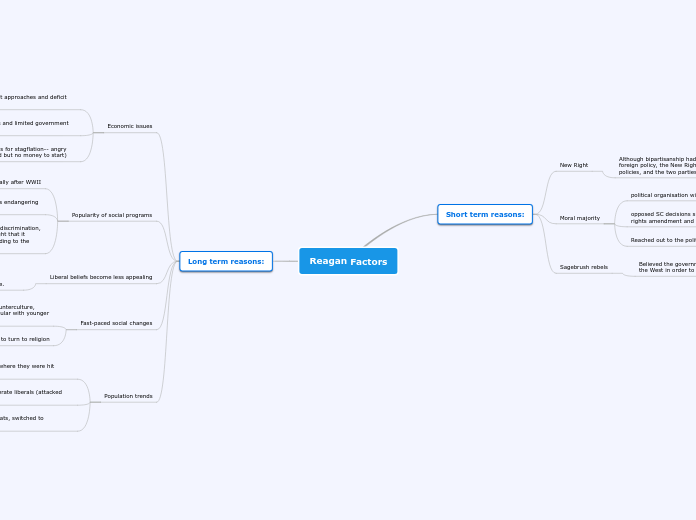Reagan Factors
Short term reasons:
New Right
Although bipartisanship had been common, especially in foreign policy, the New Right emerged as a criticism of liberal policies, and the two parties drifted farther apart ideologically
Moral majority
political organisation with religious goals
opposed SC decisions such as Engel and Roe, as well as equal rights amendment and homosexuality
Reached out to the politically apathetic-- registered new voters
Sagebrush rebels
Believed the government should release control over lands in the West in order to use their economic potential
Long term reasons:
Economic issues
Liberals still favored big government approaches and deficit spending
Conservatives favored cutting taxes and limited government regulation of industry
Conservatives blamed liberal policies for stagflation-- angry about unfunded mandates (required but no money to start)
Popularity of social programs
Liberals supported them, especially after WWII
Conservatives saw them as a waste of money, as endangering the economy, and as encouraging waste
Conservatives saw affirmative action as reverse discrimination, and welfare as rewarding little effort. they thought that it encouraged having children out of wedlock-- leading to the decline of the family.
Liberal beliefs become less appealing
People lose faith in the federal government (Watergate, Vietnam, etc), and economy and industry stagnate. additionally, urban riots split the Democratic party's base.
Fast-paced social changes
Many traditionalists felt threatened by the counterculture, mass media, and leftist thought that was popular with younger people
Caused more people to turn to religion
Population trends
More people moved to the suburbs, where they were hit financially by stagflation.
Republicans tried to gain these moderate liberals (attacked school busing)
Southern white voters, once Democrats, switched to Republicans following Civil Rights
